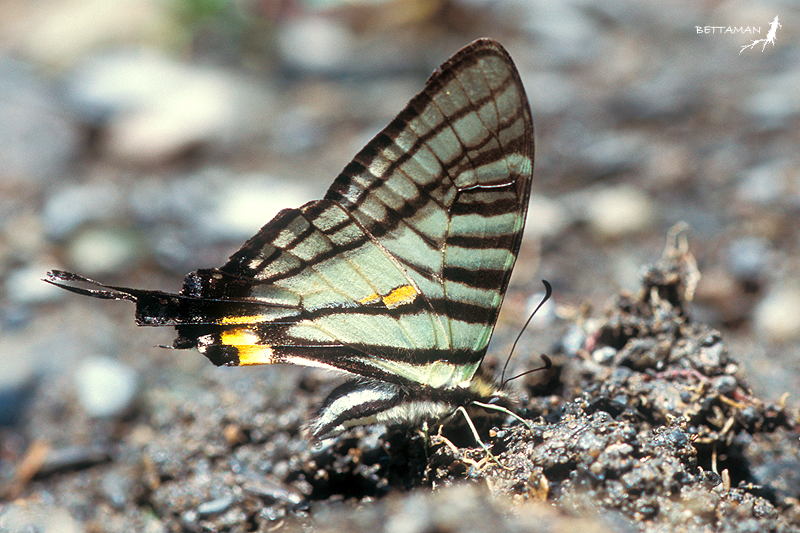
Adult life spans of butterflies (Lepidoptera: Papilionoidea+ Hesperioidea): broadscale contingencies with adult and larval traits in multi-species comparisons
Biological Journal of the Linnean Society 96(1): 166-184.
| Full Text: HTML, PDF (Size: 308K) |
JAN BECK 1* and KONRAD FIEDLER 2. (2009).
1 Institute of Biogeography, Department of Environmental Sciences, University of Basel, St Johanns-
Vorstadt 10, 4056 Basel, Switzerland
2 Department of Population Ecology, University of Vienna, Althanstrasse 14, 1090 Vienna, Austria
昆蟲的成蟲壽命據推測是適應的生活史的一部分,涉及與交配、卵的成熟、產卵有關的不同繁殖策略。作者預期成蟲壽命與其他形態、行為與生態特徵有關,並以資料探勘的方式,合併以親緣關係作對照,探討由文獻中獲得的350種鳳蝶與弄蝶物種的成蟲壽命與其他特徵相伴發生的廣泛模型。作者發現成蟲的取食習性與壽命有很強的連結,取食花粉者較食果者長壽、食蜜者再次之。此外,能降低被捕食者捕捉的特徵(如警戒色、眼紋)亦與長壽有關;而吸取泥漿以作為獲取礦物質或氮源之行為則通常與短壽相關。作者也發現物種的分布區域對壽命有顯著的影響,但是分析田野資料(熱帶物種較長壽)與圈養資料(來自熱帶的物種較短壽)得到互斥的結果。成蟲的壽命也和幼蟲時期寄主植物的生長型有關,取食藤本植物者比取食草本、灌木或喬木更長壽,至於寄主植物的其他特徵則和昆蟲的成蟲壽命沒有顯著相關。
Abstract
Adult life spans of insects are part of supposedly adaptive life-history syndromes, which involve a variety of reproductive strategies with regard to mating, egg maturation and egg laying. Contingencies of life span with many other morphological, behavioural, and ecological traits are to be expected. We used a data-mining approach, incorporating controls for phylogeny, to uncover broad patterns of trait contingencies in a literature-derived data set of adult life spans for 350 butterfly species. We found that adult feeding habit has strong links with life spans, with pollen-feeders living longer than fruit feeders, which in turn live longer than nectar feeders. Furthermore, traits reducing susceptibility to predators (i.e. aposematism, eye-spots) are associated with longer life. Mud-puddling behaviour as a means of gaining access to minerals, and possibly nitrogen, was generally associated with a short life. We also found strong impacts of the region of occurrence of species (i.e. whether they were tropical or temperate taxa), but received conflicting results depending on whether we analysed field data (longer life in the tropics) or data from caged individuals (shorter life in the tropics). Adult longevity was associated with the growth form of larval host plants (higher on lianas as opposed to herbs, shrubs, or trees), whereas other larval host plant traits did not have strong links with species' life spans. We discuss the hypothetical evolutionary mechanisms explaining those patterns and suggest predictions that could be tested in further research.
| Full Text: HTML, PDF (Size: 308K) |
JAN BECK 1* and KONRAD FIEDLER 2. (2009).
1 Institute of Biogeography, Department of Environmental Sciences, University of Basel, St Johanns-
Vorstadt 10, 4056 Basel, Switzerland
2 Department of Population Ecology, University of Vienna, Althanstrasse 14, 1090 Vienna, Austria
昆蟲的成蟲壽命據推測是適應的生活史的一部分,涉及與交配、卵的成熟、產卵有關的不同繁殖策略。作者預期成蟲壽命與其他形態、行為與生態特徵有關,並以資料探勘的方式,合併以親緣關係作對照,探討由文獻中獲得的350種鳳蝶與弄蝶物種的成蟲壽命與其他特徵相伴發生的廣泛模型。作者發現成蟲的取食習性與壽命有很強的連結,取食花粉者較食果者長壽、食蜜者再次之。此外,能降低被捕食者捕捉的特徵(如警戒色、眼紋)亦與長壽有關;而吸取泥漿以作為獲取礦物質或氮源之行為則通常與短壽相關。作者也發現物種的分布區域對壽命有顯著的影響,但是分析田野資料(熱帶物種較長壽)與圈養資料(來自熱帶的物種較短壽)得到互斥的結果。成蟲的壽命也和幼蟲時期寄主植物的生長型有關,取食藤本植物者比取食草本、灌木或喬木更長壽,至於寄主植物的其他特徵則和昆蟲的成蟲壽命沒有顯著相關。
Abstract
Adult life spans of insects are part of supposedly adaptive life-history syndromes, which involve a variety of reproductive strategies with regard to mating, egg maturation and egg laying. Contingencies of life span with many other morphological, behavioural, and ecological traits are to be expected. We used a data-mining approach, incorporating controls for phylogeny, to uncover broad patterns of trait contingencies in a literature-derived data set of adult life spans for 350 butterfly species. We found that adult feeding habit has strong links with life spans, with pollen-feeders living longer than fruit feeders, which in turn live longer than nectar feeders. Furthermore, traits reducing susceptibility to predators (i.e. aposematism, eye-spots) are associated with longer life. Mud-puddling behaviour as a means of gaining access to minerals, and possibly nitrogen, was generally associated with a short life. We also found strong impacts of the region of occurrence of species (i.e. whether they were tropical or temperate taxa), but received conflicting results depending on whether we analysed field data (longer life in the tropics) or data from caged individuals (shorter life in the tropics). Adult longevity was associated with the growth form of larval host plants (higher on lianas as opposed to herbs, shrubs, or trees), whereas other larval host plant traits did not have strong links with species' life spans. We discuss the hypothetical evolutionary mechanisms explaining those patterns and suggest predictions that could be tested in further research.

沒有留言:
張貼留言